Contributor: Jean Ndana, ASP, CSP, ASQ-SSBB, ASQ-CQE
“A worker’s first day shouldn’t be his last day on earth.”
I said these chilling words a few months ago when I narrated the tragic story of a 23-year-old temporary employee who did not return home from his first day at a Michigan factory. He was removing imperfections on spherical surfaces with a pedestal grinder when the abrasive wheel exploded. The father-to-be was fatally struck on the head by flying fragments. His death prompted a Michigan OSHA inspection, and the company was cited for several safety violations and received fines of more than $100,000. Far too many preventable incidents occur daily in workplaces across the U.S. This event was one of them. This worker’s senseless death could have been avoided had the employer developed, implemented and enforced simple but efficient grinder-related safety practices. An abrasive wheel grinder is one of the most common pieces of machinery utilized in maintenance shops and in manufacturing. These machines are used for various purposes and can be pedestal, bench-mounted or portable. After visiting and auditing many manufacturing plants, reviewing OSHA’s list of most frequently violated standards, and being the lead investigator of a fatal incident involving an abrasive wheel pedestal grinder, it became clear that abrasive wheel safety needs greater attention. This article presents 10 best practices for grinder use that are based on several years of practice as a safety practitioner in many manufacturing plants in competitive, fast-paced arenas.
10 Best Practices for Using Pedestal and Bench Grinders Safely
In FY2014, OSHA cited 1,014 serious violations related to grinders. Many of these hazards are preventable if employers and workers follow the best practices presented in this article.
Best Practice 1: Display a List of Persons Trained & Authorized to Operate, Mount & Dress Grinding Wheels at or Near the Grinder
In most workplaces, only employees properly trained in the safe use of equipment should operate it. Companies spend many resources preparing workers to safely use grinders but as time passes it becomes less clear who is trained and authorized. This problem is amplified in workplaces where workers and/or supervision change frequently. Displaying and using a list of authorized users will, not only make it easier for supervisors to conduct spot checks on grinder users but also demonstrate management’s commitment to reducing dangerous practices, including the unauthorized use of grinders by untrained employees. Figure 1 presents an excerpt from a sample form (Appendix 1).
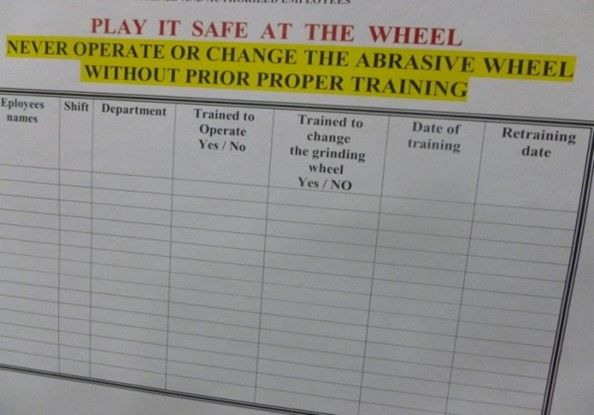
Best Practice 2: Document Each Time a New or Used Abrasive Wheel is Mounted
A mounting log (Appendix 2) identifies who mounted the wheel, as well as when and whether the wheel was visually inspected and ring tested before being mounted. A ring test is one method of checking whether a wheel is cracked or damaged. OSHA (1996) concisely describes this test in Section 1910.215(d)(1) of its abrasive wheel machinery rule: “Wheels should be tapped gently with a light nonmetallic implement such as the handle of a screwdriver for light wheels, or a wooden mallet for heavier wheels. If they sound cracked (dead), they shall not be used.” The first entry on this log confirms that the employee who mounted the wheel has been properly trained and that his/her training is still valid. The second entry addresses a critical issue: A damaged or cracked wheel is dangerous, and microscopic cracks are impossible to see with a naked eye. Thus, an employee should closely examine an abrasive wheel and ring test it before mounting it to ensure that the wheel is free of cracks and other defects that can lead to failures during use. A written tracking system also reminds workers to always examine and test a wheel before installation, and it helps monitor compliance to these critical safety rules. In addition, this log (Figure 2) provides evidence of an employer’s good faith effort to comply with OSHA standards, and it can be useful when investigating an injury involving a grinder.
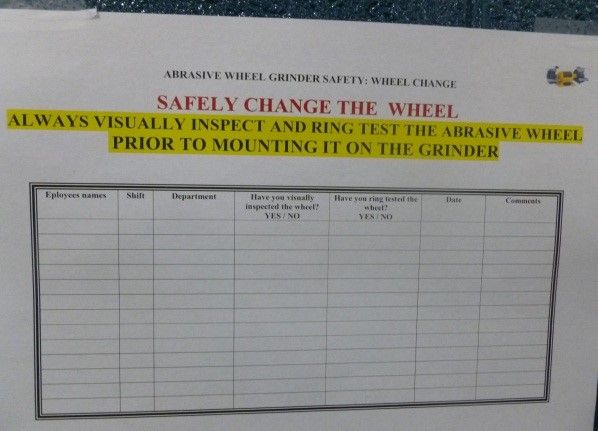
Best Practice 3: Permanently Mark an Exclusion Zone on the Floor Around the Grinder
Permanently marking an exclusion zone on the floor around the grinder serves several purposes. It visually alerts employees and visitors to potentially hazardous areas (Figure 3). With the exclusion zone marked, for instance, in yellow and black, combustible dusts are identified quickly and dealt with before they accumulate. Floor markings also remind employees that storage in this area is prohibited, and will make inadequate storage issues more apparent to management.
Safety labels and signs with important reminders, when used in conjunction with floor marking, create a visually instructive workplace – that is, a workplace where not only is the information embedded in the environment, but also employees or visitors can easily understand how a workplace operates. Galsworth (2005) reports that an easier-to-understand workplace is more efficient, productive and safe. According to Galsworth (2005), a “visual workplace is a work environment that is self-ordering, self-explaining, self-regulating and self-improving—where what is supposed to happen does happen, on time, every time, because of visual solutions” (p. 10). A visual workplace helps improve safety in several ways. To successfully create a safe work environment, safe behaviors taught must be reinforced and visuals reinforce teaching. In a busy and cramped plant, controlling the flow of people and powered industrial vehicles is an important safety concern. Marking permanent aisles and passageways is not just good practice, it is an OSHA mandate (CFR 1910.22). In a visual workplace, the environment is clean, well ordered, self-explaining and self-regulating. As a result, people are able to recognize prenear-hit conditions quickly and take corrective measures before incidents occur.
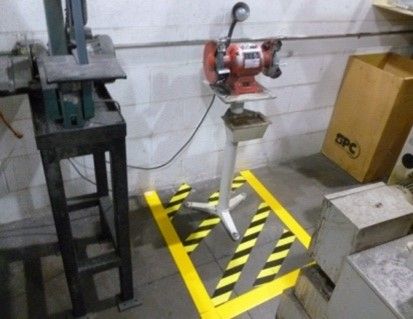
Best Practice 4: Display the Grinder’s RPM Near the Device
All grinders and abrasive wheels are rated for a maximum operating speed, usually expressed in revolutions per minute (RPM). A wheel that is operated above its rated maximum speed may shatter. If a wheel shatters while in use, an employee may be seriously injured by pieces of shattered grinding wheel flying at high speed. Therefore, the wheel’s RPM rating must be equal to or higher than the grinder’s RPM, never lower (OSHA, 1996). To effectively implement this control, the grinder’s RPM rating must be legible. For various reasons, ranging from poor maintenance and poor housekeeping, to absence of the machine data plate, the rating is not always clearly visible. Even when the rating does exist, may be difficult to discern without careful examination (Figure 4). If something cannot be easily seen or understood, it will not likely be used or heeded. In order to enhance good safety behavior and compliance to safe work procedures and practices, the efforts asked of operators must be kept to the minimum. Therefore, conspicuously posting the grinder’s RPM rating encourages worker compliance (Figure 5).
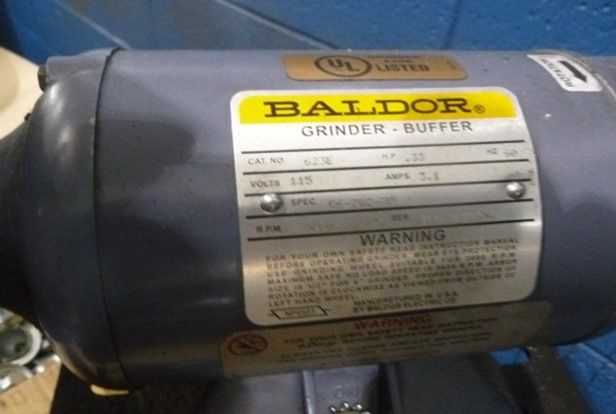
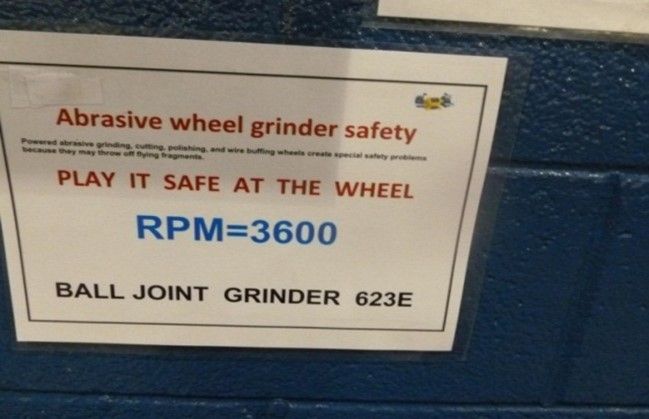
Best Practice 5: Install a Cabinet Containing Safety Glasses, a Face Shield & Disinfectant Wipes Near the Grinder
Grinder use typically releases airborne particles and generates impact hazards such as sparks, flying objects, fragments and particles. Thus, operating risks include eye and face injuries. Basic eye protection devices such as goggles or safety glasses do not protect other parts of the face. Therefore, OSHA requires that a face shield be worn over suitable basic eye protection for additional protection beyond that offered by eye protection devices alone. To eliminate health risks, safety glasses and/or face shields must be cleaned and disinfected before each use, especially when the gear is shared. In addition, having required PPE readily available at the point of use and protected from dusts encourages worker use (Figure 6). It is important to note that safety glasses/goggles and a face shield are the minimum required PPE. Certain circumstances may require additional gear (e.g., respirators, hearing protection).
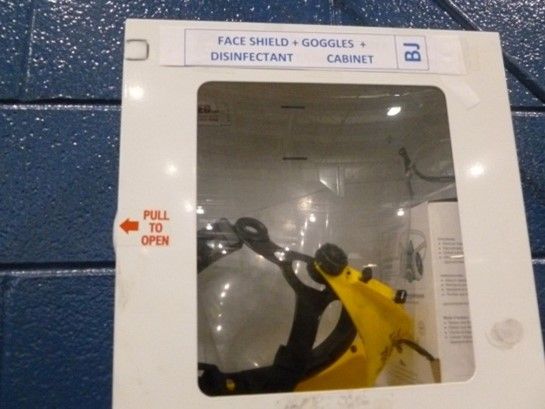
Best Practice 6: Install a Safety Gauge Near the Grinder
A common grinder-related safety violation is related to clearances. OSHA (1996) specifies that work rests must be kept close to the wheel with a maximum opening of 1/8 in. As the stone wears down from use, the rest and guard must be adjusted accordingly. This is critical because too large a gap enables the wheel to grab the workpiece or anything loose that could get caught in the machine (e.g., loose hair, dangling jewelry, a long-sleeved shirt not buttoned at the wrist) and pull everything into the grinder, which may cause serious injuries. OSHA also states that the distance between the grinding wheel and the adjustable tongue must never exceed ¼ in. A safety gauge helps employees measure these clearances easily and accurately (Figure 7).

Best Practice 7: Conduct & Document Grinder Inspections at Least Monthly
A competent person must conduct and document a comprehensive inspection at least once per month. This inspection ensures that safe operating procedures continue to be followed; that employees are familiar with the hazards associated with grinding activities and do not become complacent or take shortcuts; that they are checking work rest and adjustable tongue guard clearances before each use; and that any deviations or procedural inadequacies observed are corrected. Competent persons include workers and others with adequate knowledge of the operations, the nature of the hazards and proper procedures. During the inspection, if an unsafe action is observed, the inspector must stop the work process immediately, remind the operator of the potential hazards and coach the operator on the correct procedures. Appendix 3 presents a sample inspection checklist.
Best Practice 8: Display Signs to Remind Employees of Proper Controls
Most injuries sustained from grinder use involve loss of eye(s), amputation of fingers, lacerations, and concussions (OSHA, 1999). Grinding wheels are designed to operate at high speeds. If a wheel is defective, mounted incorrectly or misused, it may explode, and the shooting fragments can disfigure, cause permanent disabilities, or fatal injuries. Thus, grinder operators should wear full-face protection (OSHA, 2009). A well-placed sign is a permanent and consistent reminder of the proper controls.
Best Practice 9: Good Housekeeping & Cleanliness Improve Grinder Safety
Conducting abrasive wheel grinding operations creates combustible dusts and sparks. Accumulated combustible dusts can ignite and a deflagration can occur. Therefore, the area around the grinder must be free of all accumulated dust. Employees should clean the work area with a portable dust collecter as needed, such as any time they observe noticeable traces of dust, to minimize dust buildup on the machinery and the surrounding workspace. The permanent floor marking around the grinder can also quickly alert management to poor housekeeping practices that require correction (Figure 8).
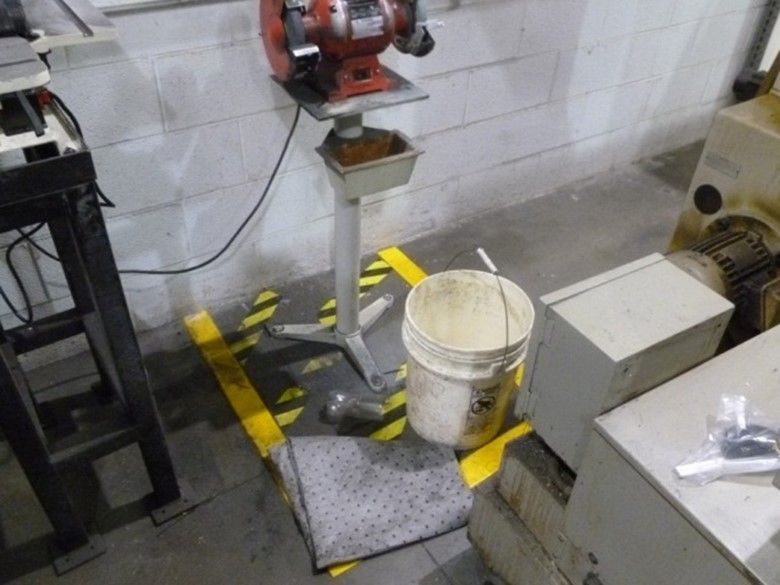
Best Practice 10: Conduct Training Annually, When Changes Occur Based on Inspection Findings
One of the annoying truisms in the health and safety field is that safety is never a sure thing, it is a permanent battle. It is only through constant awareness, good practices, and training that you can prevent accidents from occurring. Training is an effective means to fight complacency, challenge familiarity gained from frequent use of grinders, and keep workers at their best. Employees should be trained and keep abreast with how to identify the hazards and control the risks arising from operating grinders. In order to be effective, the training should not only take into account the findings of monthly inspections (7th best practice) but also be a combination of theory and practice. Profound and up-to-date theoretical knowledge should be coupled with application competencies.
The required theoretical knowledge can be acquired through visual methods such as specialized videos that discuss the risks, hazards and controls associated with the use and maintenance of pedestal and bench grinders, features scenes from a variety of job sites that show several situations where good practices are needed and used correctly, demonstrates how to conduct a ring test, and finally shows real stories of people who have witnessed or been involved in an accident involving grinders. At the end of the video, the trainer can spark a conversation among trainees by asking for example to each trainee to share with the rest of the group one or two things that struck him or her in the video.
After the theoretical phase, trainees should be asked to put into practice the knowledge gained throughout the theoretical phase. Many options are available. Trainees can be given sound abrasive wheels mixed with one or two we know for sure are cracked ones (for training purposes, they have been cracked on purpose and glued together after). Trainees are asked to spot out bad abrasive wheels. Under the supervision of the trainer, trainees can also be asked to mount an abrasive wheel. During the installation, they should explain each step they take and the other trainees are encouraged to ask questions. Why this? Why that? Why not this way? What can happen if? Etc.
Another option could be to use a twisted version of the “what’s wrong with this picture” approach which will be in this case “what’s wrong with this grinder?” A real grinder, which for training purposes has been altered to show a number of hazards, is presented to trainees. Trainees would be asked to identify those problems.
Conclusion
Pedestal and bench-mounted grinders are found in most maintenance shops and manufacturing plants. They are powerful, versatile devices used to sharpen cutting tools, drills, chisels and tool bits, and to remove surface imperfections. But operating any grinder is a hazardous work activity. A single mistake can have devastating consequences, not only to the user but also to those working nearby.
Implementing safe work and operating practices reduces the chances of incidents involving grinders, provided that management and line supervisors support those practices. Strong, visible leadership and engaged managers can motivate workers and serve as a catalyst to promote best practices. The responsibility of implementing these sound best practices and selling them to operators rests on their shoulders, and they must be fully on board with them and committed to ensuring their success.
Furthermore, when an organization employs practices shown to be effective elsewhere, worker buy-in and safety ownership can increase. An organization’s credibility also increases because it is using a tested process and has taken the forward-thinking step of confirming that it is doing the best job possible. Abrasive wheel grinders are versatile, useful devices when used safely, but extremely hazardous when not used safely.
About the Author
Jean Ndana, ASP, CSP, ASQ-SSBB, ASQ-CQE has been in the safety arena for more than 25 years. His experience spans across multiple industries including oil & gas, food & beverage, automotive, construction, and steel manufacturing.
Author of several peer-reviewed professional articles, Jean was named the 2017 J.J. Keller Safety Professional of the Year and has received an “Honorable Mention” recognition during the 2018 American Society of Safety Professionals (ASSP) Innovation Award.
Speaker and Trainer at safety conferences and professional development seminars, Jean is also an External Advisory Board Member of the University of Michigan, Center for Occupational Health and Safety Engineering (COHSE).
Member of ASSP’s Greater Detroit Chapter, Jean is also a consultant. In this role, he advises senior leaders around the globe on how to leverage their roles to improve safety performance.
Jean can be reached at ndanaflavor@gmail.com

References
Galsworth, G.D. (2005).Visual workplace/visual thinking: Creating enterprise excellence through the technologies of the visual workplace. Portland, Oregon: Visual-Lean Enterprise Press.
Oklahoma State Regents for Higher Education. (2000). Abrasive wheel grinder safety. Retrieved from http://www.okhighered.org/ssherc/newsletters/osrhe/abrasive-wheel-grinder-safety.html
U.S. Department of Labor, Occupational Safety and Health Administration (OSHA) (1996). Abrasive wheel machinery. Retrieved from https://www.osha.gov/pls/oshaweb/ owadisp.show_ document?p_id=9839&p_table=STANDARDS
U.S. Department of Labor, OSHA. (1999). Safety and health topics/machine guarding-a partial list of accidents involving grinders. Retrieved from https://www.osha.gov/SLTC/machineguarding/grinder_accidents.html
U.S. Department of Labor, OSHA. (2009). Eyes and face protection. Retrieved from https://www.osha.gov/Publications/osha3151.html
U.S. Department of Labor, OSHA. (2013). Safety and health topics/machine guarding checklist for abrasive wheel equipment grinders. Retrieved from https://www.osha.gov/ SLTC/machineguarding/new-grinder-checklist.html.
U.S. Department of Labor, OSHA. (nd). Eye and face protection eTool/selecting PPE for the workplace-Impacty. Retrieved from https://www.osha.gov/SLTC/etools/ eyeandface/ppe/impact.html